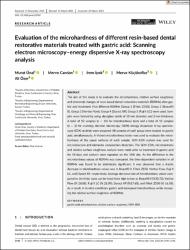| dc.contributor.author | Ünal, Murat | |
| dc.contributor.author | Candan, Merve | |
| dc.contributor.author | İpek, İrem | |
| dc.contributor.author | Küçükoflaz, Merve | |
| dc.contributor.author | Özer, Ali | |
| dc.date.accessioned | 2022-05-13T10:28:08Z | |
| dc.date.available | 2022-05-13T10:28:08Z | |
| dc.date.issued | 2021 | tr |
| dc.identifier.citation | Ünal, M, Candan, M, İpek, İ, Küçükoflaz, M, Özer, A. Evaluation of the microhardness of different resin-based dental restorative materials treated with gastric acid: Scanning electron microscopy–energy dispersive X-ray spectroscopy analysis. Microsc Res Tech. 2021; 84: 2140– 2148. https://doi.org/10.1002/jemt.23769 | tr |
| dc.identifier.uri | https://analyticalsciencejournals.onlinelibrary.wiley.com/doi/epdf/10.1002/jemt.23769 | |
| dc.identifier.uri | https://hdl.handle.net/20.500.12418/13016 | |
| dc.description.abstract | The aim of this study is to evaluate the microhardness, relative surface roughness,
and elemental changes of resin-based dental restorative materials (RDRMs) after gastric
acid treatment. Five different RDRMs (Group 1 [Filtek Z550], Group 2 [Beautifil
II], Group 3 [Vertise Flow], Group 4 [Dyract XP], Group 5 [Fuji II LC]) were used. Samples
were formed by using plexiglass molds of 10 mm diameter and 2 mm thickness.
A total of 50 samples (n = 10) for microhardness tests and a total of 15 samples
(n = 3) for scanning electron microscopy (SEM)–energy dispersive X-ray spectroscopy
(EDX) analysis were prepared. All samples of each group were treated to gastric
acid, simultaneously. A Vickers microhardness tester was used to evaluate the microhardness
of the upper surfaces of each sample. SEM–EDX system was used for
microstructure and elemental composition detection. The SEM–EDX, microhardness
and relative surface roughness analysis were made prior to treatment in gastric acid
for 14 days and analysis were repeated on the 14th day. As the difference in the
microhardness values of RDRMs was compared, the time-dependent variation in all
RDRMs was found to be statistically significant. It was observed that a drastic
decrease in microhardness values was in Beautifil II, Filtek Z550, Vertise Flow, Fuji II
LC, and Dyract XP, respectively. Average decrease rate of microhardness values compared
to the initial state can be listed from high to low as Beautifil II (%35.72), Vertise
Flow (% 28.88), Fuji II LC (% 21.09), Dyract XP (%17.60), and Filtek Z550 (% 16.58).
As a result, in in-vitro conditions gastric acid decreased microhardness while increasing
the relative surface roughness of RDRMs. | tr |
| dc.language.iso | eng | tr |
| dc.publisher | Wiley | tr |
| dc.relation.isversionof | 10.1002/jemt.23769 | tr |
| dc.rights | info:eu-repo/semantics/openAccess | tr |
| dc.subject | gastric acid | tr |
| dc.subject | microhardness | tr |
| dc.subject | relative surface roughness | tr |
| dc.subject | SEM–EDX | tr |
| dc.title | Evaluation of the microhardness of different resin-based dental restorative materials treated with gastric acid: Scanning electron microscopy–energy dispersive X-ray spectroscopy analysis | tr |
| dc.type | article | tr |
| dc.relation.journal | Microscopy Research and Technique | tr |
| dc.contributor.department | Mühendislik Fakültesi | tr |
| dc.contributor.authorID | 0000-0002-4207-8207 | tr |
| dc.identifier.volume | 84 | tr |
| dc.identifier.endpage | 2148 | tr |
| dc.identifier.startpage | 2140 | tr |
| dc.relation.publicationcategory | Uluslararası Hakemli Dergide Makale - Kurum Öğretim Elemanı | tr |















